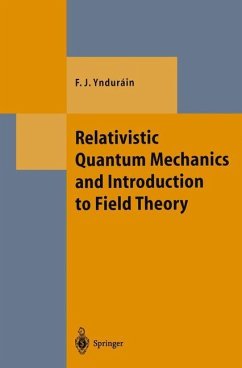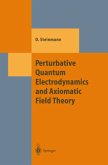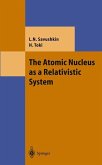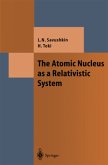Francisco J. Yndurain
Relativistic Quantum Mechanics and Introduction to Field Theory
Francisco J. Yndurain
Relativistic Quantum Mechanics and Introduction to Field Theory
- Broschiertes Buch
- Merkliste
- Auf die Merkliste
- Bewerten Bewerten
- Teilen
- Produkt teilen
- Produkterinnerung
- Produkterinnerung
A fully relativistic treatment of the quantum mechanics of particles requires the introduction of quantum field theory, that is to say, the quantum mechan ics of systems with an infinite number of degrees of freedom. This is because the relativistic equivalence of mass and energy plus the quantum possibility of fluctuations imply the existence of (real or virtual) creation and annihilation of particles in unlimited numbers. In spite of this, there exist processes, and energy ranges, where a treat ment in terms of ordinary quantum mechanical tools is appropriate, and the approximation of…mehr
Andere Kunden interessierten sich auch für
![Perturbative Quantum Electrodynamics and Axiomatic Field Theory Perturbative Quantum Electrodynamics and Axiomatic Field Theory]() Othmar SteinmannPerturbative Quantum Electrodynamics and Axiomatic Field Theory74,99 €
Othmar SteinmannPerturbative Quantum Electrodynamics and Axiomatic Field Theory74,99 €![Quantum Field Theory in Condensed Matter Physics Quantum Field Theory in Condensed Matter Physics]() Naoto NagaosaQuantum Field Theory in Condensed Matter Physics117,99 €
Naoto NagaosaQuantum Field Theory in Condensed Matter Physics117,99 €![From Microphysics to Macrophysics From Microphysics to Macrophysics]() Roger BalianFrom Microphysics to Macrophysics57,99 €
Roger BalianFrom Microphysics to Macrophysics57,99 €![The Atomic Nucleus as a Relativistic System The Atomic Nucleus as a Relativistic System]() Lev N. SavushkinThe Atomic Nucleus as a Relativistic System77,99 €
Lev N. SavushkinThe Atomic Nucleus as a Relativistic System77,99 €![A Brief Introduction to Dispersion Relations A Brief Introduction to Dispersion Relations]() José Antonio OllerA Brief Introduction to Dispersion Relations37,99 €
José Antonio OllerA Brief Introduction to Dispersion Relations37,99 €![Elementary Particle Physics Elementary Particle Physics]() Otto NachtmannElementary Particle Physics62,99 €
Otto NachtmannElementary Particle Physics62,99 €![The Atomic Nucleus as a Relativistic System The Atomic Nucleus as a Relativistic System]() Lev N. SavushkinThe Atomic Nucleus as a Relativistic System74,99 €
Lev N. SavushkinThe Atomic Nucleus as a Relativistic System74,99 €-
-
-
A fully relativistic treatment of the quantum mechanics of particles requires the introduction of quantum field theory, that is to say, the quantum mechan ics of systems with an infinite number of degrees of freedom. This is because the relativistic equivalence of mass and energy plus the quantum possibility of fluctuations imply the existence of (real or virtual) creation and annihilation of particles in unlimited numbers. In spite of this, there exist processes, and energy ranges, where a treat ment in terms of ordinary quantum mechanical tools is appropriate, and the approximation of neglecting the full field-theoretic description is justified. Thus, one may use concepts such as potentials, and wave equations, clas sical fields and classical currents, etc. The present text is devoted precisely to the systematic discussion of these topics, to which we have added a gen eral description of one- and two-particle relativistic states, in particular for scattering processes. A field-theoretic approach may not be entirely avoided, and in fact an introduction to quantum field theory is presented in this text. However, field theory is not the object per se of this book; apart from a few examples, field theory is mainly employed to establish the connection with equivalent potentials, to study the classical limit of the emission of radiation or to discuss the propagation of a fermion in classical electromagnetic fields.
Produktdetails
- Produktdetails
- Theoretical and Mathematical Physics
- Verlag: Springer / Springer Berlin Heidelberg / Springer, Berlin
- Artikelnr. des Verlages: 978-3-642-64674-4
- Softcover reprint of the original 1st ed. 1996
- Seitenzahl: 348
- Erscheinungstermin: 2. Oktober 2011
- Englisch
- Abmessung: 235mm x 155mm x 19mm
- Gewicht: 527g
- ISBN-13: 9783642646744
- ISBN-10: 3642646743
- Artikelnr.: 36122319
- Theoretical and Mathematical Physics
- Verlag: Springer / Springer Berlin Heidelberg / Springer, Berlin
- Artikelnr. des Verlages: 978-3-642-64674-4
- Softcover reprint of the original 1st ed. 1996
- Seitenzahl: 348
- Erscheinungstermin: 2. Oktober 2011
- Englisch
- Abmessung: 235mm x 155mm x 19mm
- Gewicht: 527g
- ISBN-13: 9783642646744
- ISBN-10: 3642646743
- Artikelnr.: 36122319
1. Relativistic Transformations. The Lorentz Group.- 1.1 Rotations, and Space and Time Reversal for Particles with Spin.- 1.2 Galilean Transformations.- 1.3 Lorentz Transformations. Normal Parameters.- 1.4 Minkowski Space. The Full Lorentz Group.- 1.5 The Lorentz Group.- 1.6 Geometry of Minkowski Space.- 1.7 Transformation Properties of Physical Quantities Under the Lorentz Group.- 1.8 Covariant Form of the Maxwell Equations.- 1.9 Minkowski Space: Metric, Conventions.- 2. The Klein-Gordon Equation. Relativistic Equation for Spinless Particles.- 2.1 The Klein-Gordon Equation. Generalities.- 2.2 Wave Equation for Free Spinless Particles.- 2.3 Plane Waves. Current. Scalar Product.- 2.4 Interaction with the Classical Electromagnetic Field. Gauge Invariance.- 2.5 Particle in a Coulomb Field.- 3. Spin 1/2 Particles.- 3.1 The Dirac Equation.- 3.2 Invariance Properties of the Dirac Equation.- 3.2.1 Rotations.- 3.2.2 Boosts.- 3.2.3 Parity.- 3.2.4 Time Reversal.- 3.3 Density of Particles. Current. Scalar Product.- 3.4 Minimal Replacement. Gauge Invariance. Large and Small Components: Nonrelativistic Limit of the Dirac Equation....- 3.5 Plane Waves. States with Weil-Defined Spin.- 3.6 Radial Form of the Dirac Equation. Free-Particle Solutions.- 3.6.1 Radial Form of H.- 3.6.2 Free Particles.- 3.7 The Problem of Negative Energies in the Dirac Equation. The Dirac Sea. Hole Theory. Charge Conjugation.- 3.7.1 Negative Energies. The Dirac Sea. Holes.- 3.7.2 Charge Conjugation.- 3.8 Covariants and Projectors.- 3.8.1 Covariants.- 3.8.2 Projectors.- 3.9 Massless Spin 1/2 Particles.- 4. Dirac Particle in a Potential.- 4.1 Dirac Particle in a Spherical Well.- 4.2 Particle in a Coulomb Potential: Continuum States.- 4.3 Scattering States. Phase Shifts. Cross-sections. Wave Function at theOrigin.- 4.3.1 Scattering States. Phase Shifts.- 4.3.2 Cross-sections.- 4.3.3 Wave Function at the Origin.- 4.4 Bound States in a Coulomb Potential.- 4.5 Semirelativistic Approximation: the Foldy-Wouthuysen Transformation.- 4.5.1 General Method.- 4.5.2 Electromagnetic Interactions.- 4.5.3 Free Particle.- 5. Massive Particles with Spin 1. Massless Spin 1 Particle: Photon Wave Functions. Particles with Higher Spins (3/2, 2,...).- 5.1 Particle with Spin 1 and Mass m ? 0.- 5.2 Particle with Spin 1 and Zero Mass: The Photon. Plane Waves. Photon Spin.- 5.2.1 Photon Wave Function. Gauge Fixing. Transformation Properties.- 5.2.2 Plane Waves. Helicity States.- 5.2.3 Field Variables as Wave Functions for the Photon. The Schwinger Gauge.- 5.3 Angular Momentum Eigenstates for the Photon. Vector Spherical Harmonics. Multipoles.- 5.3.1 General Useful Formulas.- 5.3.2 Multipoles.- 5.3.3 Photon Wave Functions with Well-Defined Angular Momentum.- 5.4 Particles with Higher Spins. Rarita-Schwinger and Bargmann-Wigner Equations. The Graviton.- 5.4.1 Rarita-Schwinger Equations.- 5.4.2 Bargmann-Wigner Equations.- 5.4.3 The Graviton.- 6. General Description of Relativistic States.- 6.1 Preliminaries.- 6.2 Relativistic One-Particle States: General Description.- 6.3 Relativistic States of Massive (m?0) Particles.- 6.4 Massless Particles.- 6.5 Many-Particle States. Creation-Annihilation Operators. Fock Space.- 6.6 Connection with the Wave Function Formalism.- 7. General Description of Relativistic Collisions: S Matrix, Cross-sections and Decay Rates. Partial Wave Analyses.- 7.1 Two-Particle States. Separation of the Centre of Mass Motion. States with Weil-Defined Angular Momentum.- 7.2 Kinematics of Two-Particle Collisions.- 7.3 The S Matrix. Scattering Amplitude.Nonrelativistic Limit.- 7.4 Cross-sections and Decay Rates. The Optical Theorem.- 7.5 Partial Wave Analysis and Phase Shifts. I. Spinless Elastic Scattering. Effective Range Expansion....- 7.5.1 Partial Wave Analysis.- 7.5.2 Effective Range Formalism.- 7.6 Partial Wave Analysis. II. Several Two-Body Channels.- 7.6.1 Multichannel Analysis.- 7.6.2 Effective Range Approximation.- 7.7 Partial Wave Analysis. III. Particles with Spin.- 7.7.1 Spin Analysis.- 7.7.2 Scattering of Spin 0 - Spin 1/2 Particles.- 7.8 Evaluation of the S Matrix.- 7.8.1 The S Matrix and the Interaction Picture.- 7.8.2 The S Matrix in the Lippmann-Schwinger Formalism..- 7.8.3 Scattering by Two Interactions.- 8. Quantization of the Electromagnetic Field. Interaction of Radiation with Matter.- 8.1 Normal, or Wick, Products.- 8.2 Quantization of the Electromagnetic Field (Coulomb Gauge). The Casimir Effect.- 8.2.1 Quantization of the Electromagnetic Field.- 8.2.2 Multipole Expansion.- 8.2.3 The Casimir Effect.- 8.3 Interaction of the Radiation with Slowly Moving Particles....- 8.3.1 Radiative Decays, and Absorption of Radiation.- 8.3.2 Low-Energy Compton Scattering.- 8.4 Bremsstrahlung.- 8.5 The Classical Limit. Coherent States.- 8.6 Uncertainty Relations for Field Variables.- 9. Quantum Fields: Spin 0, 1/2, 1. Covariant Quantization of the Electromagnetic Field.- 9.1 Generalities.- 9.2 Localization of Particles in Relativistic Quantum Mechanics..- 9.3 Retardation and Consistency.- 9.4 Quantization of Scalar Fields and of Massive Vector Fields....- 9.4.1 Second Quantization for Spinless Particles.- 9.4.2 Massive Vector Particles.- 9.5 Quantization of the Dirac Field. Weyl and Majorana Particles.- 9.6 Covariant Quantization of the Electromagnetic Field.- 9.6.1 The Gupta-Bleuler Space.- 9.6.2 Covariant Transformation.- 9.6.3 The Metric Operator Method.- 9.7 Time-Ordered Product. Propagators.- 9.8 Interactions in Quantum Field Theory. Lagrangian Formulation.- 9.8.1 Lagrangian Formalism for Fields.- 9.8.2 Interactions.- 9.9 Gauge Invariance in Quantum Electrodynamics.- 10. Interactions in Quantum Field Theory. Nonrelativistic Limit. Reduction to Equivalent Potential.- 10.1 Potentials Equivalent to Field-Theoretic Interactions. General Method.- 10.2 Equivalent Potential for Two Particles in Electromagnetic Interaction.- 10.2.1 Elastic Collision of Two Charged Particles in the Born Approximation.- 10.2.2 Nonrelativistic Limit.- 10.2.3 Relativistic Corrections. The Breit Term.- 10.3 Hydrogenlike Atoms: Hyperfine Structure. System with Two Electrons: the Helium Atom.- 10.3.1 Hydrogenlike Atoms.- 10.3.2 System With Two Electrons. The Helium Atom.- 10.4 Electron-Positron Collisions: Effective Potential. Positronium.- 10.4.1 Scattering Amplitude in the Born Approximation..- 10.4.2 Annihilation Channel.- 10.4.3 Positronium.- 10.5 Scalar and Pseudoscalar Interactions. The Yukawa Potential..- 10.6 Weak Neutral Currents. Parity Violation in Atoms.- 11. Relativistic Collisions in Field Theory. Feynman Rules. Decays.- 11.1 Electron-Positron Annihilation into Two Photons, and Pair Creation by Two-Photon Collisions.- 11.1.1 e+e- Annihilation into 2?.- 11.1.2 Creation of an e+e- Pair by Two Photons.- 11.2 Feynman Rules. Gauge Invariance.- 11.2.1 Feynman Rules for the Evaluation of Transition Amplitudes.- 11.2.2 Gauge Invariance.- 11.3 Polarized and Unpolarized Cross-sections. Sums Over Polarizations.- 11.4 Compton Scattering (Relativistic).- 11.5 Decay of Bound States.- 11.5.1 General Theory.- 11.5.2 Decays of Positronium.- 11.5.3 Decay of Muonium into e+e-. Decays of Quarkonium.- 12.Relativistic Interactions with Classical Sources.- 12.1 Interaction with a Fixed (Classical) Potential.- 12.1.1 Scattering by an External Field.- 12.1.2 Bremsstrahlung.- 12.2 Photon Emission by a Classical Source. The Bloch-Nordsieck Theorem. Classical Limit.- 12.2.1 Classical Radiation.- 12.2.2 Photon Emission by a Classical Current.- 12.2.3 Radiation of Coherent States.- 12.2.4 The Bloch-Nordsieck Theorem.- 12.3 Propagation of an Electron in a Classical Potential. The Proper-Time Method.- 12.3.1 Electron in a Coulomb Potential.- 12.3.2 The Proper-Time Method.- 12.3.3 Dirac Particle in a Constant Field, or in a Plane Wave.- Appendices.- A.1 Spherical Harmonics, Clebsch-Gordan Coefficients, Matrix Representations of the Rotation Group.- A.1.1 Spherical Harmonics.- A.1.2 Some Specific Values.- A.1.3 Multiplication Formulas.- A.1.4 Gegenbauer-like Formulas.- A.1.5 Spinor and Vector Spherical Harmonics.- A.1.6 Clebsch-Gordan Coefficients.- A.1.7 Rotation Matrices.- A.2 Special Functions.- A.2.1 Kummer, or Confluent Hypergeometric Functions.- A.2.2 Bessel Functions.- A.2.3 Spherical Bessel Functions.- A.2.4 Bessel Functions of the Second Kind.- A.2.5 Laguerre Polynomials.- A.4 ? Matrices.- A.4.1 The Pauli Realization.- A.4.2 The Weyl Realization.- A.4.3 The Majorana Realization.- A.6 Physical Quantities.- A.6.1 SI (Gauss) Units.- A.6.3 Other Relations.- References.
1. Relativistic Transformations. The Lorentz Group.- 1.1 Rotations, and Space and Time Reversal for Particles with Spin.- 1.2 Galilean Transformations.- 1.3 Lorentz Transformations. Normal Parameters.- 1.4 Minkowski Space. The Full Lorentz Group.- 1.5 The Lorentz Group.- 1.6 Geometry of Minkowski Space.- 1.7 Transformation Properties of Physical Quantities Under the Lorentz Group.- 1.8 Covariant Form of the Maxwell Equations.- 1.9 Minkowski Space: Metric, Conventions.- 2. The Klein-Gordon Equation. Relativistic Equation for Spinless Particles.- 2.1 The Klein-Gordon Equation. Generalities.- 2.2 Wave Equation for Free Spinless Particles.- 2.3 Plane Waves. Current. Scalar Product.- 2.4 Interaction with the Classical Electromagnetic Field. Gauge Invariance.- 2.5 Particle in a Coulomb Field.- 3. Spin 1/2 Particles.- 3.1 The Dirac Equation.- 3.2 Invariance Properties of the Dirac Equation.- 3.2.1 Rotations.- 3.2.2 Boosts.- 3.2.3 Parity.- 3.2.4 Time Reversal.- 3.3 Density of Particles. Current. Scalar Product.- 3.4 Minimal Replacement. Gauge Invariance. Large and Small Components: Nonrelativistic Limit of the Dirac Equation....- 3.5 Plane Waves. States with Weil-Defined Spin.- 3.6 Radial Form of the Dirac Equation. Free-Particle Solutions.- 3.6.1 Radial Form of H.- 3.6.2 Free Particles.- 3.7 The Problem of Negative Energies in the Dirac Equation. The Dirac Sea. Hole Theory. Charge Conjugation.- 3.7.1 Negative Energies. The Dirac Sea. Holes.- 3.7.2 Charge Conjugation.- 3.8 Covariants and Projectors.- 3.8.1 Covariants.- 3.8.2 Projectors.- 3.9 Massless Spin 1/2 Particles.- 4. Dirac Particle in a Potential.- 4.1 Dirac Particle in a Spherical Well.- 4.2 Particle in a Coulomb Potential: Continuum States.- 4.3 Scattering States. Phase Shifts. Cross-sections. Wave Function at theOrigin.- 4.3.1 Scattering States. Phase Shifts.- 4.3.2 Cross-sections.- 4.3.3 Wave Function at the Origin.- 4.4 Bound States in a Coulomb Potential.- 4.5 Semirelativistic Approximation: the Foldy-Wouthuysen Transformation.- 4.5.1 General Method.- 4.5.2 Electromagnetic Interactions.- 4.5.3 Free Particle.- 5. Massive Particles with Spin 1. Massless Spin 1 Particle: Photon Wave Functions. Particles with Higher Spins (3/2, 2,...).- 5.1 Particle with Spin 1 and Mass m ? 0.- 5.2 Particle with Spin 1 and Zero Mass: The Photon. Plane Waves. Photon Spin.- 5.2.1 Photon Wave Function. Gauge Fixing. Transformation Properties.- 5.2.2 Plane Waves. Helicity States.- 5.2.3 Field Variables as Wave Functions for the Photon. The Schwinger Gauge.- 5.3 Angular Momentum Eigenstates for the Photon. Vector Spherical Harmonics. Multipoles.- 5.3.1 General Useful Formulas.- 5.3.2 Multipoles.- 5.3.3 Photon Wave Functions with Well-Defined Angular Momentum.- 5.4 Particles with Higher Spins. Rarita-Schwinger and Bargmann-Wigner Equations. The Graviton.- 5.4.1 Rarita-Schwinger Equations.- 5.4.2 Bargmann-Wigner Equations.- 5.4.3 The Graviton.- 6. General Description of Relativistic States.- 6.1 Preliminaries.- 6.2 Relativistic One-Particle States: General Description.- 6.3 Relativistic States of Massive (m?0) Particles.- 6.4 Massless Particles.- 6.5 Many-Particle States. Creation-Annihilation Operators. Fock Space.- 6.6 Connection with the Wave Function Formalism.- 7. General Description of Relativistic Collisions: S Matrix, Cross-sections and Decay Rates. Partial Wave Analyses.- 7.1 Two-Particle States. Separation of the Centre of Mass Motion. States with Weil-Defined Angular Momentum.- 7.2 Kinematics of Two-Particle Collisions.- 7.3 The S Matrix. Scattering Amplitude.Nonrelativistic Limit.- 7.4 Cross-sections and Decay Rates. The Optical Theorem.- 7.5 Partial Wave Analysis and Phase Shifts. I. Spinless Elastic Scattering. Effective Range Expansion....- 7.5.1 Partial Wave Analysis.- 7.5.2 Effective Range Formalism.- 7.6 Partial Wave Analysis. II. Several Two-Body Channels.- 7.6.1 Multichannel Analysis.- 7.6.2 Effective Range Approximation.- 7.7 Partial Wave Analysis. III. Particles with Spin.- 7.7.1 Spin Analysis.- 7.7.2 Scattering of Spin 0 - Spin 1/2 Particles.- 7.8 Evaluation of the S Matrix.- 7.8.1 The S Matrix and the Interaction Picture.- 7.8.2 The S Matrix in the Lippmann-Schwinger Formalism..- 7.8.3 Scattering by Two Interactions.- 8. Quantization of the Electromagnetic Field. Interaction of Radiation with Matter.- 8.1 Normal, or Wick, Products.- 8.2 Quantization of the Electromagnetic Field (Coulomb Gauge). The Casimir Effect.- 8.2.1 Quantization of the Electromagnetic Field.- 8.2.2 Multipole Expansion.- 8.2.3 The Casimir Effect.- 8.3 Interaction of the Radiation with Slowly Moving Particles....- 8.3.1 Radiative Decays, and Absorption of Radiation.- 8.3.2 Low-Energy Compton Scattering.- 8.4 Bremsstrahlung.- 8.5 The Classical Limit. Coherent States.- 8.6 Uncertainty Relations for Field Variables.- 9. Quantum Fields: Spin 0, 1/2, 1. Covariant Quantization of the Electromagnetic Field.- 9.1 Generalities.- 9.2 Localization of Particles in Relativistic Quantum Mechanics..- 9.3 Retardation and Consistency.- 9.4 Quantization of Scalar Fields and of Massive Vector Fields....- 9.4.1 Second Quantization for Spinless Particles.- 9.4.2 Massive Vector Particles.- 9.5 Quantization of the Dirac Field. Weyl and Majorana Particles.- 9.6 Covariant Quantization of the Electromagnetic Field.- 9.6.1 The Gupta-Bleuler Space.- 9.6.2 Covariant Transformation.- 9.6.3 The Metric Operator Method.- 9.7 Time-Ordered Product. Propagators.- 9.8 Interactions in Quantum Field Theory. Lagrangian Formulation.- 9.8.1 Lagrangian Formalism for Fields.- 9.8.2 Interactions.- 9.9 Gauge Invariance in Quantum Electrodynamics.- 10. Interactions in Quantum Field Theory. Nonrelativistic Limit. Reduction to Equivalent Potential.- 10.1 Potentials Equivalent to Field-Theoretic Interactions. General Method.- 10.2 Equivalent Potential for Two Particles in Electromagnetic Interaction.- 10.2.1 Elastic Collision of Two Charged Particles in the Born Approximation.- 10.2.2 Nonrelativistic Limit.- 10.2.3 Relativistic Corrections. The Breit Term.- 10.3 Hydrogenlike Atoms: Hyperfine Structure. System with Two Electrons: the Helium Atom.- 10.3.1 Hydrogenlike Atoms.- 10.3.2 System With Two Electrons. The Helium Atom.- 10.4 Electron-Positron Collisions: Effective Potential. Positronium.- 10.4.1 Scattering Amplitude in the Born Approximation..- 10.4.2 Annihilation Channel.- 10.4.3 Positronium.- 10.5 Scalar and Pseudoscalar Interactions. The Yukawa Potential..- 10.6 Weak Neutral Currents. Parity Violation in Atoms.- 11. Relativistic Collisions in Field Theory. Feynman Rules. Decays.- 11.1 Electron-Positron Annihilation into Two Photons, and Pair Creation by Two-Photon Collisions.- 11.1.1 e+e- Annihilation into 2?.- 11.1.2 Creation of an e+e- Pair by Two Photons.- 11.2 Feynman Rules. Gauge Invariance.- 11.2.1 Feynman Rules for the Evaluation of Transition Amplitudes.- 11.2.2 Gauge Invariance.- 11.3 Polarized and Unpolarized Cross-sections. Sums Over Polarizations.- 11.4 Compton Scattering (Relativistic).- 11.5 Decay of Bound States.- 11.5.1 General Theory.- 11.5.2 Decays of Positronium.- 11.5.3 Decay of Muonium into e+e-. Decays of Quarkonium.- 12.Relativistic Interactions with Classical Sources.- 12.1 Interaction with a Fixed (Classical) Potential.- 12.1.1 Scattering by an External Field.- 12.1.2 Bremsstrahlung.- 12.2 Photon Emission by a Classical Source. The Bloch-Nordsieck Theorem. Classical Limit.- 12.2.1 Classical Radiation.- 12.2.2 Photon Emission by a Classical Current.- 12.2.3 Radiation of Coherent States.- 12.2.4 The Bloch-Nordsieck Theorem.- 12.3 Propagation of an Electron in a Classical Potential. The Proper-Time Method.- 12.3.1 Electron in a Coulomb Potential.- 12.3.2 The Proper-Time Method.- 12.3.3 Dirac Particle in a Constant Field, or in a Plane Wave.- Appendices.- A.1 Spherical Harmonics, Clebsch-Gordan Coefficients, Matrix Representations of the Rotation Group.- A.1.1 Spherical Harmonics.- A.1.2 Some Specific Values.- A.1.3 Multiplication Formulas.- A.1.4 Gegenbauer-like Formulas.- A.1.5 Spinor and Vector Spherical Harmonics.- A.1.6 Clebsch-Gordan Coefficients.- A.1.7 Rotation Matrices.- A.2 Special Functions.- A.2.1 Kummer, or Confluent Hypergeometric Functions.- A.2.2 Bessel Functions.- A.2.3 Spherical Bessel Functions.- A.2.4 Bessel Functions of the Second Kind.- A.2.5 Laguerre Polynomials.- A.4 ? Matrices.- A.4.1 The Pauli Realization.- A.4.2 The Weyl Realization.- A.4.3 The Majorana Realization.- A.6 Physical Quantities.- A.6.1 SI (Gauss) Units.- A.6.3 Other Relations.- References.








